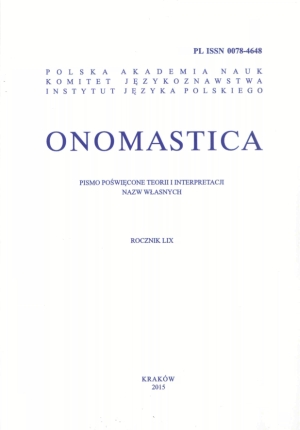Streszczenie
The Internet as an Issue for Onomastic and Medioonomastic Studies
Previous onomastic research into proper names in the Internet has typically been based on tradition- al and classic onomastic methodology. As a result, researchers have focused on the classification of names, the analysis of their structure, etymology, or function. In this paper, this traditional approach is compared with the new possibilities afforded by medioonomastics, a fast growing method which is combining the onomastic tradition and mediolinguistics. This paper provides only an outline and is only preliminary, although some analysis is also presented. It reviews onomastic techniques and the medioonomastic analysis of the names that function within the various types of texts in the Internet. Some examples are taken from Internet memes, as well as from Facebook profiles. One of these names is the Polish given name, Janusz, which is a brilliant example of the specific new functions, connotations and general semantic values generated by the Internet. This name has gained a new meaning: ‘a typical Polish man’, ‘unfashionable man’, ‘a redneck’. Another name is the title of the Facebook profile Chujowa Pani Domu, based on the TV-series Perfekcyjna Pani Domu, as a kind of semantic and pragmatic re-construction of the latter name. In the conclusion, the necessity of considering not only the type of object-named, but also the medium and especially the Internet, is emphasized. Such studies may offer a correct procedure for analysis which include the new medioonomastic methodology.
Bibliografia
Bajerowa, I. (1980). Wpływ techniki na ewolucję języka polskiego. Nauka dla Wszystkich, 309. Wrocław: Ossolineum.
Cieślikowa, A. (1996). Metody w onomastycznych badaniach różnych kategorii nazw własnych. Onomastica, XLI, s. 5–20.
Czopek-Kopciuch, B. (2004). Nick — nowa kategoria onomastyczna. W: K. Michalewski (red.), Współczesne odmiany języka narodowego. Łódź: Wyd. UŁ, s. 106–111.
Graf, M. (2003). E-nimy jako nowa kategoria nazewnicza. W: M. Biolik (red.), Metodologia badań onomastycznych. Olsztyn: Wyd. UWM, s. 639–643.
Griffin, E. (2003). Podstawy komunikacji społecznej. Przeł. O. i W. Kubińscy, M. Kacmajor. Gdańsk: Gdańskie Wyd. Psychologiczne.
Kita, M. (2016). Językoznawcy wobec badań języka w Internecie. Artes Humanae, 1, s. 111–124.
Loewe, I. (2006). Internet i jego zasoby w polskich badaniach lingwistycznych. Biuletyn PTJ, LXII, s. 93–103.
Łobodzińska, R., Peisert, M. (2003). Nazwy własne w przestrzeni wirtualnej. W: M. Biolik (red.), Metodologia badań onomastycznych. Olsztyn: Wyd. UWM, s. 644–653.
Misztal, B. (2010). Różnorodność form pseudonimicznych w Internecie — próba klasyfikacji nicków. Słowo. Studia Językoznawcze, 1, s. 129–135.
Naruszewicz-Duchlińska, A. (2003). Pseudonimy internetowe (nicknames) jako forma autoreklamy. Prace Językoznawcze, 5, s. 85–98.
Naruszewicz-Duchlińska, A. (2015). Nienawiść w czasach Internetu. Gdynia: Novae Res.
Rutkiewicz, M. (1999). Onomastyczny status irconimów. Onomastica, XLIV, s. 115–123.
Rutkowski, M. (2016). Medioonomastyka w ramach mediolingwistyki. Prace Językoznawcze, 18/3, s. 171–180.
Siwiec, A. (2014). Pseudonimy internetowe vel nicki — charakterystyka onomastyczna i uzus. Roczniki Humanistyczne, LXII, z. 6., s. 101–122.
Siwiec, A. (2017). O nacechowanych dyskursywnie użyciach nazw własnych w memach internetowych. W: D. Filar, P. Krzyżanowski (red.), Barwy słów. Studia lingwistyczno-kulturowe. Lublin: Wyd. UMCS, s. 687–711.
Skowronek, B. (2013). Mediolingwistyka. Wprowadzenie. Kraków: Wyd. Naukowe UP.
Skowronek, K., Rutkowski, M. (2004). Media i nazwy. Z zagadnień onomastyki medialnej, Kraków: Lexis.
Szpunar, M. (2012). Nowe-stare medium. Internet między tworzeniem nowych modeli komunikacyjnych a reprodukowaniem schematów komunikowania masowego. Warszawa: IFiS PAN.
Szymański, L. (2013). Leksyka czatu internetowego. Studium empiryczne. Zielona Góra: Oficyna Wydawnicza Uniwersytetu Zielonogórskiego.
Taras, B. (2004). Anonim w Internecie, czyli o komunikacji incognito. W: M. Kita, J. Grzenia (red.), Dialog a nowe media. Katowice: Wyd. UŚ, s. 42–45.


